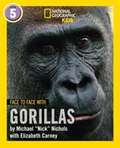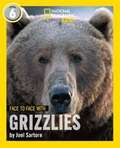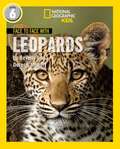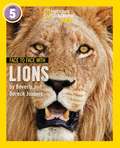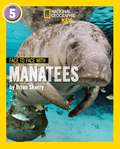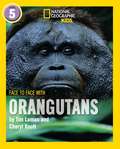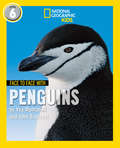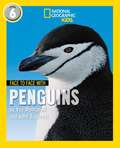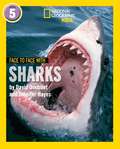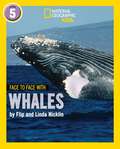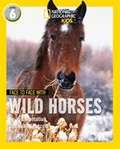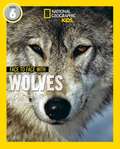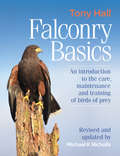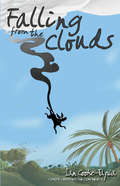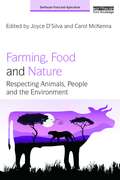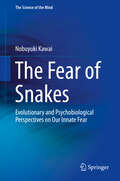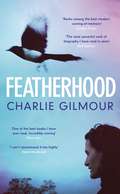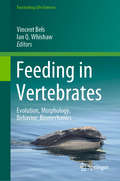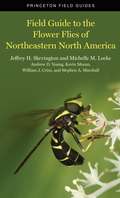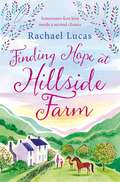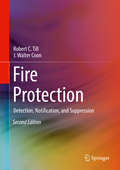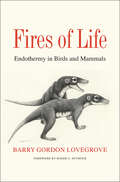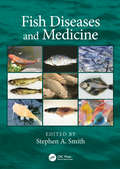- Table View
- List View
Face To Face With Gorillas: Level 5 (PDF)
by Michael Nichols Elizabeth CarneyNational Geographic Face to Face Readers is a high-interest series of books for confident, independent readers that have been adapted to a Key Stage 2 audience by education experts. The books pair magnificent National Geographic photographs with lively first-person text and fascinating facts about the natural world. Journey deep into the jungle with experienced nature photographers to learn about one of humankind’s closest cousins. Written in an engaging and fun to read format, the captivating photos and fascinating facts are perfect for encouraging the future explorers and primatologists of tomorrow! Level 5 readers are ideal for kids who are confident in reading independently and ready for the challenge of varied sentence lengths, some technical vocabulary and increasing inference.
Face To Face With Grizzlies: Level 6 (National Geographic Readers Ser.)
by Joel SartoreNational Geographic Face to Face Readers is a high-interest series of books for confident, independent readers that have been adapted to a Key Stage 2 audience by education experts. The books pair magnificent National Geographic photographs with lively first-person text and fascinating facts about the natural world. Join nature photographer Joel Sartore as he journeys into the world of the fearsome and fierce Grizzly Bear. Written in an engaging and fun to read format, the captivating photos and fascinating facts are perfect for encouraging the future explorers and researchers of tomorrow! Level 6 readers are ideal for kids who are very confident in reading independently and ready to challenge themselves with a wide variety of sentence structures and writing styles, a range of new technical vocabulary and the need for more complex inference.
FACE TO FACE WITH LEOPARDS: Level 6 (National Geographic Readers)
by Dereck Joubert Beverly JoubertNational Geographic Face to Face Readers is a high-interest series of books for confident, independent readers that have been adapted to a Key Stage 2 audience by education experts. The books pair magnificent National Geographic photographs with lively first-person text and fascinating facts about the natural world. Journey deep into the African brush with nature photographers as they take you inside the secretive world of these elusive cats. Written in an engaging and fun to read format, the captivating photos and fascinating facts are perfect for encouraging the future explorers and researchers of tomorrow! Level 6 readers are ideal for kids who are very confident in reading independently and ready to challenge themselves with a wide variety of sentence structures and writing styles, a range of new technical vocabulary and the need for more complex inference.
Face To Face With Lions: Level 5 (PDF)
by Dereck Joubert Beverly JoubertNational Geographic Face to Face Readers is a high-interest series of books for confident, independent readers that have been adapted to a Key Stage 2 audience by education experts. The books pair magnificent National Geographic photographs with lively first-person text and fascinating facts about the natural world. Journey to the plains of Africa and join experienced nature photographers Dereck and Beverly Joubert to learn all about the fearsome and magnificent lion. Written in an engaging and fun to read format, the captivating photos and fascinating facts are perfect for encouraging the future explorers and scientists of tomorrow! Level 5 readers are ideal for kids who are confident in reading independently and ready for the challenge of varied sentence lengths, some technical vocabulary and increasing inference.
Face To Face With Manatees: Level 5 (PDF)
by Brian Skerry Elizabeth CarneyNational Geographic Face to Face Readers is a high-interest series of books for confident, independent readers that have been adapted to a Key Stage 2 audience by education experts. The books pair magnificent National Geographic photographs with lively first-person text and fascinating facts about the natural world. Dive deep into the watery world of Manatees with an experienced nature photographer and learn all about these gentle giants. Written in an engaging and fun to read format, the captivating photos and fascinating facts are perfect for encouraging the future explorers and marine biologists of tomorrow! Level 5 readers are ideal for kids who are confident in reading independently and ready for the challenge of varied sentence lengths, some technical vocabulary and increasing inference.
Face To Face With Orangutans: Level 5 (PDF)
by Tim Laman Cheryl KnottNational Geographic Face to Face Readers is a high-interest series of books for confident, independent readers that have been adapted to a Key Stage 2 audience by education experts. The books pair magnificent National Geographic photographs with lively first-person text and fascinating facts about the natural world. Journey to the rainforests of Borneo and join experienced nature photographers to learn all about these highly intelligent, tree-dwelling primates. Written in an engaging and fun to read format, the captivating photos and fascinating facts are perfect for encouraging the future explorers and primatologists of tomorrow! Level 5 readers are ideal for kids who are confident in reading independently and ready for the challenge of varied sentence lengths, some technical vocabulary and increasing inference.
Face to Face with Penguins: Level 6 (National Geographic Readers)
by Yva Momatiuk John EastcottNational Geographic Face to Face Readers is a high-interest series of books for confident, independent readers that have been adapted to a Key Stage 2 audience by education experts. The books pair magnificent National Geographic photographs with lively first-person text and fascinating facts about the natural world.
FACE TO FACE WITH PENGUINS (National Geographic Readers)
by Yva Momatiuk John EastcottNational Geographic Face to Face Readers is a high-interest series of books for confident, independent readers that have been adapted to a Key Stage 2 audience by education experts. The books pair magnificent National Geographic photographs with lively first-person text and fascinating facts about the natural world. Wrap up warm and get ready to visit the wild world of these waddling wonders. Learn all about the life of a Penguin; from where they live, to what they eat, to just how it is they can survive in the harshest places on Earth. Written in an engaging and fun to read format, the captivating photos and fascinating facts are perfect for encouraging the future explorers and researchers of tomorrow! Level 6 readers are ideal for kids who are very confident in reading independently and ready to challenge themselves with a wide variety of sentence structures and writing styles, a range of new technical vocabulary and the need for more complex inference.
Face To Face With Sharks: Level 5 (PDF)
by David Doubilet Jennifer HayesNational Geographic Face to Face Readers is a high-interest series of books for confident, independent readers that have been adapted to a Key Stage 2 audience by education experts. The books pair magnificent National Geographic photographs with lively first-person text and fascinating facts about the natural world. Dive down deep (in a cage!) to the underwater world of the shark and learn all about these fantastically fearsome hunters. Are they as scary as we think? Written in an engaging and fun to read format, the captivating photos and fascinating facts are perfect for encouraging the future explorers and marine biologists of tomorrow! Level 5 readers are ideal for kids who are confident in reading independently and ready for the challenge of varied sentence lengths, some technical vocabulary and increasing inference.
Face To Face With Whales: Level 5 (National Geographic Readers Ser.)
by Flip Nicklin Linda NicklinNational Geographic Face to Face Readers is a high-interest series of books for confident, independent readers that have been adapted to a Key Stage 2 audience by education experts. The books pair magnificent National Geographic photographs with lively first-person text and fascinating facts about the natural world. Grab your diving gear and journey deep under the sea with experienced nature photographers Flip and Linda Nicklin to learn all about these magnificent underwater giants. Written in an engaging and fun to read format, the captivating photos and fascinating facts are perfect for encouraging the future explorers and marine biologists of tomorrow! Level 5 readers are ideal for kids who are confident in reading independently and ready for the challenge of varied sentence lengths, some technical vocabulary and increasing inference.
Face To Face With Wild Horses: Level 6 (PDF)
by Yva Momatiuk John EastcottNational Geographic Face to Face Readers is a high-interest series of books for confident, independent readers that have been adapted to a Key Stage 2 audience by education experts. The books pair magnificent National Geographic photographs with lively first-person text and fascinating facts about the natural world. Gallop off to join nature photographers as they take you on a journey inside the enchanting world of the wild horse. From forests, to mountains, to deserts, to grasslands, these untamed beauties adapt, survive and thrive. Written in an engaging and fun to read format, the captivating photos and fascinating facts are perfect for encouraging the future explorers and researchers of tomorrow! Level 6 readers are ideal for kids who are very confident in reading independently and ready to challenge themselves with a wide variety of sentence structures and writing styles, a range of new technical vocabulary and the need for more complex inference.
FACE TO FACE WITH WOLVES: Level 6 (National Geographic Readers)
by Jim Brandenburg Judy BrandenburgExam board: AQA, Edexcel, OCR, Eduqas; Cambridge Assessment International Education Level & Subject: GCSE 9-1 English Literature; IGCSE Literature in English First teaching: September 2015; September 2018 First examination: June 2017; June 2020 This edition of Macbeth is perfect for GCSE-level students, with the complete play in an accessible format, on-page notes, introduction setting the context, timeline, character and theme indexes. Affordable high quality complete play for Macbeth, ideal for GCSE 9-1 and IGCSE Demystify vocabulary with notes on the page and concise commentary Set the scene with perfectly pitched introductions that introduce key contexts, concerns and stylistic features, and examine different performances and interpretations Recall plot summaries at the beginning of each scene Support GCSE revision and essay writing with theme and character indexes Help students with social, historical and literary context with the bespoke timeline of Shakespeare's life and times
Falconry Basics: An Introduction to the Care, Maintenance and Training of Birds of Prey
by Tony HallFalconry is an ancient and noble art, still practiced today by falconers throughout the world. While, these days, falconry birds are mostly bred in captivity, they are still wild, independent animals and owning and training them requires the right commitment, knowledge and skills. Falconry Basics is designed to provide those new to falconry with the essential information they need, including the basics of types of birds and their individual characteristics; acquiring the proper equipment; how best to care for and maintain healthy birds, and all aspects of training, flying and hunting. Accompanied by diagrams and line drawings throughout, and with additional material, such as a glossary of falconry terms, this newly revised and updated edition offers a comprehensive, practical guide for a whole new generation of falconers.
Falling from the Clouds: How Coyote Realised His World Was Smaller Than He Thought (Coyote Crosses the Continent #1)
by Ian Cooke-TapiaCoyote knows everything there is to know about his homeland. From the sea to the east,to the ocean to the west; it is all known to him. He knows the desert and the plains and the spires. Coyote knows too how to get any creature and the land itself do what he wants and believe it is their idea. One day, as Coyote walks the clouds in search of food, he notices a creature he had never seen before. Meeting Khirkinchu, the Giant Armadillo, makes Coyote realise that the world he thinks he knows is small indeed. And that just can’t do! He is Coyote, and he should know everything there is to know about the world. Full of curiosity and energy Coyote sets out in search of the southern lands. Yet Kirkinchu warns him that he will never reach them unless he meets the King of the Vultures.
Farming, Food and Nature: Respecting Animals, People and the Environment (Earthscan Food and Agriculture)
by Joyce D'Silva Carol McKennaLivestock production and its use of finite resources is devastating biodiversity and pushing wildlife to the brink of extinction. This powerful book examines the massive global impact caused by intensive livestock production and then explores solutions, ranging from moving to agroecological farming to reducing consumption of animal products, including examples of best practice and innovation, both on land and within the investment and food industries. Leading international contributors spell out the problems in terms of planetary limits, climate change, resources, the massive use of cereals and soy for animal feed, and the direct impact of industrial farming on the welfare of farmed animals. They call for an urgent move to a flourishing food system for the sake of animals, the planet and us. Some offer examples of global good practice in farming or the power of the investment community to drive change, and others highlight food business innovation and exciting developments in protein diversification. Providing a highly accessible overview of key issues, this book creates a timely resource for all concerned about the environmental, social and ethical issues facing food, farming and nature. It will be an invaluable resource and provide inspiration for students, professionals, non-governmental organisations (NGOs) and the general reader.
Farming, Food and Nature: Respecting Animals, People and the Environment (Earthscan Food and Agriculture)
by Joyce D'Silva Carol McKennaLivestock production and its use of finite resources is devastating biodiversity and pushing wildlife to the brink of extinction. This powerful book examines the massive global impact caused by intensive livestock production and then explores solutions, ranging from moving to agroecological farming to reducing consumption of animal products, including examples of best practice and innovation, both on land and within the investment and food industries. Leading international contributors spell out the problems in terms of planetary limits, climate change, resources, the massive use of cereals and soy for animal feed, and the direct impact of industrial farming on the welfare of farmed animals. They call for an urgent move to a flourishing food system for the sake of animals, the planet and us. Some offer examples of global good practice in farming or the power of the investment community to drive change, and others highlight food business innovation and exciting developments in protein diversification. Providing a highly accessible overview of key issues, this book creates a timely resource for all concerned about the environmental, social and ethical issues facing food, farming and nature. It will be an invaluable resource and provide inspiration for students, professionals, non-governmental organisations (NGOs) and the general reader.
The Fear of Snakes: Evolutionary and Psychobiological Perspectives on Our Innate Fear (The Science of the Mind)
by Nobuyuki KawaiThis book provides a series of compelling evidence that shows that humans have innate fear of snakes. Building on the previous studies on the Snake Detection Theory (SDT), the author presents a summary of psychological and neuropsychological experiments to explain the fear of snakes in humans and primates. Readers will come to understand why and how we are afraid of snakes from an evolutionary perspective.The first half of the book discusses the history of psychological behaviorism and neobehaviorism. The latter half of the book consists mainly of the experimental studies performed by the author with a focus on three key items: First, compared with other animals, snakes especially draw the attention of primates and humans. Second, the ability of primates and humans to recognize snakes with particular efficiency. Third, processing mechanisms within the brain for snake detection is discussed from a new viewpoint.The book offers a unique resource for all primatologists, psychologists, neuroscientists, anthropologists, herpetologists, and biologists who are interested in the evolution of visual and cognitive systems, mechanisms of fear, snakes or primates.
Featherhood: On Birds and Fathers
by Charlie GilmourThis is a story about birds and fathers.About the young magpie that fell from its nest in a Bermondsey junkyard into Charlie Gilmour's life - and swiftly changed it. Demanding worms around the clock, riffling through his wallet, sharing his baths and roosting in his hair... About the jackdaw kept at a Cornish stately home by Heathcote Williams, anarchist, poet, magician, stealer of Christmas, and Charlie's biological father who vanished from his life in the dead of night. It is a story about repetition across generations and birds that run in the blood; about a terror of repeating the sins of the father and a desire to build a nest of one's own. It is a story about change - from wild to tame; from sanity to madness; from life to death to birth; from freedom to captivity and back again, via an insane asylum, a prison and a magpie's nest. And ultimately, it is the story of a love affair between a man and a magpie.
Feeding in Vertebrates: Evolution, Morphology, Behavior, Biomechanics (Fascinating Life Sciences)
by Vincent Bels Ian Q. WhishawThis book provides students and researchers with reviews of biological questions related to the evolution of feeding by vertebrates in aquatic and terrestrial environments. Based on recent technical developments and novel conceptual approaches, the book covers functional questions on trophic behavior in nearly all vertebrate groups including jawless fishes. The book describes mechanisms and theories for understanding the relationships between feeding structure and feeding behavior. Finally, the book demonstrates the importance of adopting an integrative approach to the trophic system in order to understand evolutionary mechanisms across the biodiversity of vertebrates.
Field Guide to the Flower Flies of Northeastern North America (Princeton Field Guides #134)
by Jeffrey H Skevington Michelle M. Locke Andrew D. Young Kevin Moran William J Crins Stephen A. MarshallA groundbreaking guide to flower flies in North America This is the first comprehensive field guide to the flower flies (also known as hover flies) of northeastern North America. Flower flies are, along with bees, our most important pollinators. Found in a varied range of habitats, from backyard gardens to aquatic ecosystems, these flies are often overlooked because many of their species mimic bees or wasps. Despite this, many species are distinctive and even subtly differentiated species can be accurately identified. This handy and informative guide teaches you how.With more than 3,000 color photographs and 400 maps, this guide covers all 416 species of flower flies that occur north of Tennessee and east of the Dakotas, including the high Arctic and Greenland. Each species account provides information on size, identification, abundance, and flight time, along with notes on behavior, classification, hybridization, habitats, larvae, and more.Summarizing the current scientific understanding of our flower fly fauna, this is an indispensable resource for anyone, amateur naturalist or scientist, interested in discovering the beauty of these insects.· 3000+ color photos (field and museum shots)· Multiple images per species, with arrows highlighting key field marks· Grayscale images showing the actual size of the insect· Range maps for each species· Information on size, identification features, abundance, flight times, and more
Field Guide to the Flower Flies of Northeastern North America (Princeton Field Guides #134)
by Jeffrey H Skevington Michelle M. Locke Andrew D. Young Kevin Moran William J Crins Stephen A. MarshallA groundbreaking guide to flower flies in North America This is the first comprehensive field guide to the flower flies (also known as hover flies) of northeastern North America. Flower flies are, along with bees, our most important pollinators. Found in a varied range of habitats, from backyard gardens to aquatic ecosystems, these flies are often overlooked because many of their species mimic bees or wasps. Despite this, many species are distinctive and even subtly differentiated species can be accurately identified. This handy and informative guide teaches you how.With more than 3,000 color photographs and 400 maps, this guide covers all 416 species of flower flies that occur north of Tennessee and east of the Dakotas, including the high Arctic and Greenland. Each species account provides information on size, identification, abundance, and flight time, along with notes on behavior, classification, hybridization, habitats, larvae, and more.Summarizing the current scientific understanding of our flower fly fauna, this is an indispensable resource for anyone, amateur naturalist or scientist, interested in discovering the beauty of these insects.· 3000+ color photos (field and museum shots)· Multiple images per species, with arrows highlighting key field marks· Grayscale images showing the actual size of the insect· Range maps for each species· Information on size, identification features, abundance, flight times, and more
Finding Hope at Hillside Farm: The Heartwarming Feel-Good Story from the Author of Sealed With a Kiss
by Rachael LucasFinding Hope at Hillside Farm is a heartwarming tale of loss, love and new beginnings by Rachael Lucas.'A heartwarming and enchanting read that reminds us of the value of patience, kindness and above all love' - Cathy Bramley'Wonderfully warm, brave and wise, it’s a gentle story that steals your heart and reaffirms your hope in life' - Miranda Dickinson'A gorgeous grown-up romance where loss collides with love . . . Full of warmth, heart and humanity' - Laura KempHillside Farm, nestled in the rolling hills of the Welsh countryside, is a safe haven for Ella. Living on the remote farm, with just horses and her aunt Bron for company, Ella thinks she has finally found a place where she can forget her past and find peace.But the arrival of a small girl called Hope and her father Harry changes everything. As Ella helps the pair come to terms with their loss, she realizes that she too deserves happiness. But is it too late to find it?The perfect read for fans of Cathy Bramley, Laura Kemp and Milly JohnsonWhat readers are saying:'A story about love, hope, letting go of the past and forgiveness. This book is beautiful' 'I've just romped through this unputdownable book' 'This is a book to enjoy by the fire on a cold evening' 'There is romance, an incredible storyline and drama. You can smell the Welsh hills and feel the Welsh sunshine on your face' 'I love Rachael Lucas (gushes hugely) I am completely biased and would 100% read her shopping list if she published it!'
Fire Protection: Detection, Notification, and Suppression
by Robert C. Till J. Walter CoonThe Second Edition of this introduction to fire protection systems is completely revised and updated to offer the student, architect or engineer the basics of fire protection devices and equipment, and how they may be applied to any given project. Fire Protection: Detection, Notification, and Suppression reveals the “nuts and bolts” of fire protection system selection, design and equipment in an applied approach. Whether a mechanical engineer, safety engineer, architect, estimator, fire service personnel, or student studying in these areas, the authors show the pros and the cons of protection systems being proposed, and how they should be compared to one another. It also gives non-fire engineering practitioners a sense of proportion when they are put in a position to select a consultant, and to give a sense of what the consultant may be doing and how a system is being matched to the hazard. Beginning fire protection engineers could also use its language for writing a report about these systems for a client.
Fires of Life: Endothermy in Birds and Mammals
by Barry Gordon LovegroveA groundbreaking argument on how endothermy—arguably the most important innovation in vertebrate evolution—developed in birds and mammals This pioneering work investigates why endothermy, or “warm-bloodedness,” evolved in birds and mammals, despite its enormous energetic costs. Arguing that single-cause hypotheses to explain the origins of endothermy have stalled research since the 1970s, Barry Gordon Lovegrove advances a novel conceptual framework that considers multiple potential causes and integrates data from the southern as well as the northern hemisphere. Drawing on paleontological data; research on extant species in places like the Karoo, Namaqualand, Madagascar, and Borneo; and novel physiological models, Lovegrove builds a compelling new explanation for the evolution of endothermy. Vividly narrated and illustrated, this book stages a groundbreaking argument that should prove provocative and fascinating for specialists and lay readers alike.
Fish Diseases and Medicine
by Stephen A. SmithFish are critically important to the welfare of this planet and its occupants, the health of both wild and captive fish populations paramount to our survival. This book presents the gross pathology of the most commonly encountered diseases and syndromes of fish in an organ system-based approach. It provides an overview of the di
